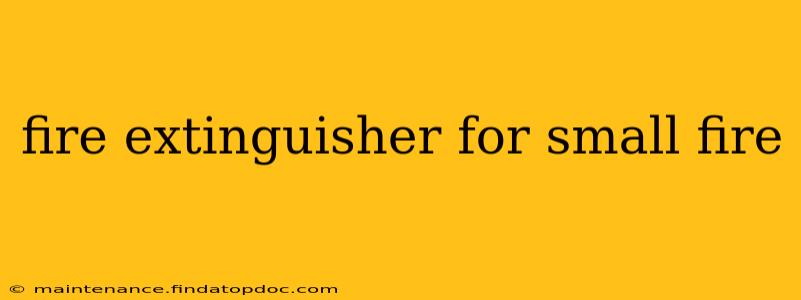Small fires can quickly escalate into major emergencies, causing significant damage and posing serious risks to life and property. Knowing how to choose and use the right fire extinguisher is crucial for effective fire suppression in such situations. This guide will walk you through selecting the appropriate extinguisher for small fires and provide essential safety tips.
What Type of Fire Extinguisher is Best for Small Fires?
The best type of fire extinguisher for a small fire depends entirely on the class of fire you're facing. Fire classes are categorized based on the material fueling the fire:
-
Class A: Ordinary combustibles like wood, paper, cloth, and some plastics. These fires are best extinguished with water-based extinguishers (indicated by a green triangle).
-
Class B: Flammable liquids like gasoline, oil, grease, and solvents. These require extinguishers using carbon dioxide (CO2) (indicated by a red square), dry chemical, or foam.
-
Class C: Electrical fires involving energized electrical equipment. Never use water on an electrical fire! CO2, dry chemical, or halon extinguishers (indicated by a blue circle) are suitable.
-
Class D: Combustible metals like magnesium, titanium, and sodium. These require specialized extinguishers not commonly found in homes or small businesses.
-
Class K: Cooking oils and greases. These require special wet chemical extinguishers designed to prevent reignition.
Many home fire extinguishers are ABC extinguishers, meaning they can be used on Class A, B, and C fires. This makes them versatile and suitable for many common household fire scenarios. However, remember that an ABC extinguisher is not effective against Class D or K fires.
What Size Fire Extinguisher Do I Need for a Small Fire?
For small fires at home or in a small office, a 2A10BC or 3A40BC fire extinguisher is generally sufficient. The numbers indicate the extinguisher's rating: The first number represents its effectiveness against Class A fires, the second against Class B fires. A higher number indicates a greater extinguishing capacity. The "BC" denotes its effectiveness against Class B and C fires. Larger extinguishers are better suited for larger fires or commercial settings; however, a smaller extinguisher is easier to handle and maneuver in a small space.
How to Use a Fire Extinguisher for a Small Fire (PASS Method)
Before using any fire extinguisher, remember the PASS method:
- P - Pull: Pull the pin.
- A - Aim: Aim the nozzle at the base of the fire.
- S - Squeeze: Squeeze the lever slowly and steadily.
- S - Sweep: Sweep the nozzle from side to side, covering the base of the fire.
Crucially: Only attempt to extinguish a small fire if it’s safe to do so. If the fire is spreading rapidly, or if you feel unsafe at any point, evacuate the building immediately and call emergency services.
What are the Different Types of Fire Extinguishers?
Several types of fire extinguishers exist, each suited for different classes of fire:
-
Water: Effective against Class A fires. Not suitable for Class B, C, or D fires.
-
Foam: Effective against Class A and B fires. Not suitable for Class C or D fires.
-
Dry Chemical: Effective against Class A, B, and C fires.
-
Carbon Dioxide (CO2): Effective against Class B and C fires. Leaves no residue, but can cause frostbite on contact.
-
Wet Chemical: Specifically designed for Class K fires (cooking oils and greases).
How Often Should I Inspect My Fire Extinguisher?
Regular inspection is crucial. Check your fire extinguisher monthly for:
- Pressure gauge: Ensure the needle is in the green zone.
- Nozzle: Check for any obstructions or damage.
- Overall condition: Look for any signs of damage, corrosion, or leaks.
Have your fire extinguisher professionally serviced annually by a qualified technician.
What Should I Do If My Fire Extinguisher Doesn't Work?
If your fire extinguisher fails to work, immediately evacuate the building and call the emergency services. Do not attempt to use a malfunctioning extinguisher. Report the incident to your local fire department and have the extinguisher replaced or serviced.
Where Should I Place My Fire Extinguisher?
Fire extinguishers should be placed in a visible and accessible location, away from potential fire hazards but easily reachable in case of an emergency. Keep them in a well-lit area and ensure nothing obstructs access.
Remember, prevention is always better than cure. Regular home safety checks, including smoke detector maintenance, are essential for minimizing fire risks. Knowing how to choose and use a fire extinguisher correctly can be invaluable in protecting your life and property.
